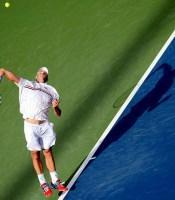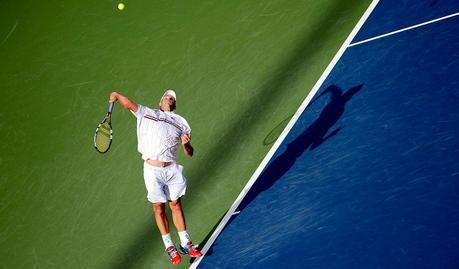


Whether it’s a height advantage, the fact they can apply wicked pace and/or spin, or that they have the arm power to just smack the crap out of it, opponents with big serves can be very intimidating to play. And because of this, a lot of players give up early, thinking that there’s no chance to ever break them.
But the more you play, the easier it gets to pick apart your opponent’s serve, despite their advantage of height and/or power.
Take Any Roddick, for example. For years, no one could handle his massive serve. But after a while, his opponents started to figure out how to return it, and Roddick started seeing a lot of service breaks, and a lot of losses.
If you come across an opponent with a massive serve, don’t sweat it – neutralize it! And here are some great tips to help you do just that:
Win your service game
Of course, you don’t want to lose your serve at all, but you definitely don’t want to lose your serve to someone who could potentially win all of theirs. If this happens, it will give your opponent more courage to take bigger risks on your returns, knowing that the chance of being broken themselves is quite small. DON’T give them this opportunity.
Don’t back up
Moving back opens up the court, increasing the distance that you have to cover in order to return the ball, and giving your opponent a better chance of nailing an ace.
Take the ball on the rise
Stand just inside the baseline line, shorten your back swing and take the ball on the rise. This way you’ll be closer, and better able to cut off angles. You’ll also be able to better use the server’s own pace to return the ball, giving your opponent very little time to react to your return.
Receive it where YOU want it
If your opponent prefers serving down the T on the deuce side, take a step to your left and force his/her to go to your forehand. Recreational players will usually (and unwillingly) oblige, so make sure you’ve got your Continental grip ready. I’m not suggesting you do this on every point, just every now and again. This is very frustrating for the opponent as it takes away her control and allows you to dictate where she serves.
Wrong-foot your opponent
Though this can also work in doubles, it’s an excellent singles strategy, and one that the pros use all the time. Once you get the point started, open the court by hitting out wide and forcing your opponent off the court. Then when he/she is hustling to get back into position, smack the ball in the direction he/she was coming from. It’s difficult to quickly do a 1-80 (even for the pros), so if they do to get their racket on the ball, the return will more than likely result in either an error, or an easy put away. And if they get lucky and return it well, just keep the rally going until you can get him/her out wide again. NOTE: This is not the best shot choice for slow movers, as they’ll won’t have moved very far and might be able to return the ball.
Keep them on the move
This really applies to singles players. Once you return the serve, wear them down by running them from corner to corner. When running, players tend to hit the ball more up the middle (the lowest point of the net) and with less pace, which should make it easier for you to keep it going. The longer they’re in the point, the more tired and frustrated they’ll get, and the greater the chance that they’ll make the error. It’ll also create more opportunities to wrong-foot them.
Note any quirky behaviors
Study your server and make mental notes of things he/she does differently before a big serve. Maybe he/she prefers to stand in a certain spot to serve their bullet to your backhand. Or maybe he/she will change grips before delivering their wicked kick serve. When you notice these things, you’ll be able to start anticipating what type of serve it will be, and where it will go.
Take away the net
For me, there is nothing more intimidating than an opponent who serves and volleys. OK… SO this type of server doesn’t necessarily have a big serve, but to me, intimidation is BIG. Use your lobs, chip-and-charge or rush in on short shots, and YOU take the net and force them to try and pass you. This may not work consistently, but it will at least make your opponent panic for a moment or two, and hopefully make an error.
Remember these tips the next time your opponent is an Andy Roddick wannabe, or someone who is big on intimidation, and you’ll cut them down to size!

